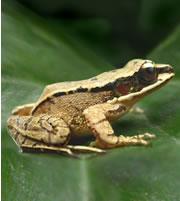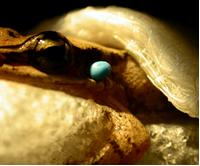 The Chinese concave-eared torrent frog is the first amphibian known to communicate in ultrasound.Credit Albert Feng
The Chinese concave-eared torrent frog is the first amphibian known to communicate in ultrasound.Credit Albert FengThe concave-eared torrent frog could give opera divas a run for their money. Reaching a pitch in the ultrasonic range, these frogs perform arias to be heard over the rushing waters of their habitat, the Huangshan Hot Springs in China.
Ultrasonic communication uses sound at a frequency greater than the upper limits of human hearing, around 20 kilohertz, and is thought to exist only in certain mammals, such as bats, whales and some rodents. Now it seems that some frogs have evolved the ability to hit the high notes. Researchers have now measured the torrent frogs (Amolops tormotus) warbling at up to 34 kilohertz.
"This is somewhat amazing," says Albert Feng, an acoustic specialist at the Beckman Institute at the University of Illinois, Urbana, and lead author of a paper in the latest issue of Nature1.
Feng had previously noted the frogs' ability to sing in the ultrasonic range (see 'Frog sings like a bird'). But it wasn't clear until now that the frogs were actually using this to communicate, rather than it being a side-effect of more audible croaking.
Many frogs have evolved visual signals to complement their croaks and make them more noticeable to mates, says herpetologist Michael Ryan of the University of Texas, Austin. The torrent frog, he says, seems to have taken a different tactic in its noisy environment.
Distant drums
 What was that? A frog with ear plugs can't hear ultrasonic cries.Credit Albert Feng
What was that? A frog with ear plugs can't hear ultrasonic cries.Credit Albert FengFeng first became interested in the frogs after Kraig Adler, a biology professor at Cornell University when Feng was a graduate student there, told him about his field work with the species in China. Unlike common frogs, whose ears sit at the edge of their face, the torrent frog has visible ear canals that lead to a sunken eardrum within the skull.
This intrigued Adler. "I thought this frog must have an unusual communication system to account for this shape," he says.
So Feng recorded the frogs' audible and ultrasonic sounds. He then played these to a group of eight male frogs to see if they would croak in response.
Five of the eight replied to the ultrasonic calls. Feng suspects that the three that did not respond could still hear the cries, but did not have the vocal prowess to reply. Frog species usually have some males that do not engage in croaking, he says.
Ear plugs
ADVERTISEMENT
It is possible for ultrasound to penetrate the body and stimulate nerves directly. So to check that the frogs were using their ears to pick up the ultrasound, the team blocked them with modelling clay and exposed the frogs to the cries again. The frogs did not respond, and the auditory nerves in their brains did not fire, so Feng concludes that the ears are involved.
The team has yet to study female frogs, which do not have such odd, sunken ears.
If it turns out that the female frogs cannot hear ultrasound, it will prompt the question of what the cries are for, says Ryan. "One thing is for certain," he adds. "It's going to open the door for a whole range of behavioural studies."
Visit our chatin_ultrasound.html">newsblog to read and post comments about this story.
-
References
- Feng A. S., et al. Nature, 440. 333 - 336 (2006). | Article |
